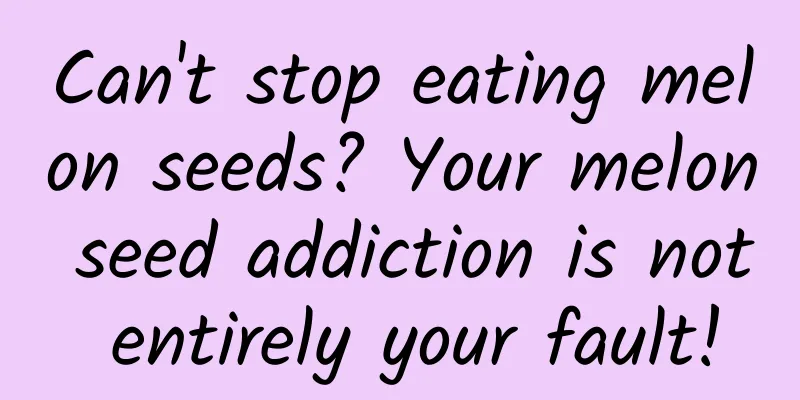Can't stop eating melon seeds? Your melon seed addiction is not entirely your fault!

|
Melon seeds, as the well-deserved king of national snacks, are unique in China and abroad, and have dominated the past and present. Pumpkin seeds, watermelon seeds, sunflower seeds, Qia Qia melon seeds... There are many types of melon seeds, but there is only one way to eat them: Eat! In Feng Zikai's essays, eating melon seeds is a unique way of leisure for Chinese people: “The Chinese, who enjoy sunflower seeds to the fullest, are truly remarkable and active practitioners of leisure! Just look at the hot sales of sunflower seeds in candy and southern food stores, and the sunflower seed shells scattered all over the floor of teahouses, hotels, and homes. You can imagine how much time the Chinese waste in the sound of “ge, pai” and “de, dei”. The number of hours counted each year must be staggering. If this trend develops in the future, I’m afraid that the whole of China will be wiped out by the sound of “ge, pai” and “de, dei”.” During every festive season, among the dazzling array of snacks, melon seeds are always indispensable; no matter how big the mountain of melon seeds in front of you is, its final destination is only one - a mountain of melon seed shells of the same size. As we enter modern society, the festive atmosphere of the New Year has faded, and the concept of healthy eating has emerged. The dangers of cracking melon seeds have long been known to all: melon seed teeth caused by damaged tooth enamel, damage to oral mucosa, and high levels of oil, sugar and salt, which make it a junk food that goes straight for the three highs... But all of this still cannot stop the Chinese people's love for melon seeds, and cannot stop the evil hands from reaching out to the melon seed pile again and again. So after every holiday, when you stand on the scale and pinch the extra two layers of fat on your belly, in addition to setting a goal to lose weight again, you might as well think about this scientific question with me - Why can’t I stop eating melon seeds? Before answering this question, let’s think back to the process of eating melon seeds. If we ignore the complicated details of peeling, the process is very simple: open a bag of melon seeds (ah, so fragrant) - take out a seed - crack it - spit out the shell - take out another seed - ... ah, another bag... Why can’t we stop eating sunflower seeds? The answer seems obvious—because they are delicious! Wait a minute, let me ask you two questions: 1. Is the temptation of melon seeds really just because of the melon seeds themselves? In other words, when you start eating melon seeds, is it because they smell good or because you are greedy? 2. Does the smell of melon seeds explain the addiction to melon seeds? Is it "liking" or "wanting" that drives addictive behavior? To answer the above two questions, let's re-examine the process of eating sunflower seeds. In fact, the whole behavior can be divided into two stages: the initial stage, that is, opening the package, taking out the sunflower seeds, and eating the first one; the repetition stage, that is, the two behaviors of taking out the sunflower seeds and eating the sunflower seeds are repeated until the sunflower seeds are all eaten. To answer the reason for the addiction to eating sunflower seeds, we need to focus on two stages: the triggering of the initial stage and the maintenance of the repetition stage. 1. The trigger at the beginning: the smell of melon seeds and my greed Aroma, as a comprehensive sensory signal of smell and taste, originates from a group of neurons in the cerebral cortex that love food. It is an evolutionary mechanism formed by humans crawling on the evolutionary tree for millions of years. In other words, the "aroma" of food is ultimately an evolutionary imprint engraved in our DNA by our ancestors. Back before the Stone Age, our ancestors experienced the cruel law of survival of the fittest together with other creatures in the primeval forest, competing for food to obtain the energy and inorganic salts needed for survival. Fortunately (at least for that era), one of our ancestors had the ability to identify high sugar, high fat, and high salt - and the secret to their ability was that the brain defined food containing these three substances as "fragrant". After the sifting of natural selection, this gene was deeply engraved into the human genome and was highly conserved, but it also failed to adapt to the drastic changes in modern society and became another legacy of evolution. As seeds of oil crops, sunflower seeds contain essential oils. In sunflower seeds, oil accounts for an astonishing 43.5%, mainly oleic acid and linoleic acid[1]. In addition, like all junk food, industrially processed sunflower seeds contain large amounts of sugar and salt, as well as a number of spices, to stimulate appetite. All of these coincide with the definition of "fragrant". So how does the smell of melon seeds arouse people’s appetite? This involves the downstream pathway of the complex feeling of “smell”, which is the same principle as the stomach growling at the sight of delicious food: the signal transmitted by food stimulates the secretion of human digestive juices, triggers hunger, and induces eating behavior. The secretion of digestive juices in the human body can be divided into three stages according to the part of the digestive tract that senses food stimulation: the cephalic stage, the gastric stage, and the intestinal stage. As the name suggests, the cephalic stage of gastric juice secretion is the process of stimulating the secretion of digestive juices before food enters the stomach, and the amount of secretion is mainly affected by appetite [2]. The production of appetite involves both unconditioned and conditioned reflexes[2]—when chewing food, the aroma and texture of the food is transmitted to the brain through smell, taste and touch, which is the unconditioned stimulus of food; the plum tree in the story of quenching thirst with plums, the picture of drawing cakes to appease hunger, the bells that Pavlov's dogs heard, and even the scene of the host feasting on food in the video of eating live, are conditioned stimuli. Both stimuli can send a signal to the brain: "I'm going to eat now—" Then the brain commands the digestive glands and cells in the stomach to secrete digestive juices through the vagus nerve[2], which can be said to be "the food and grass must go before the troops move." Image source: Physiology/Gastric secretion - Medical Encyclopedia (yixue.com) Just imagine, when you open a bag of melon seeds, you are filled with the overflowing aroma of oil and tempting spices; when you bite open the melon seed shell, accompanied by a fine "crunch", the sour, sweet and salty taste instantly flows over the tip of your tongue; with every slight chewing, the simple and graceful aroma of oil slowly diffuses in your mouth... Even if your stomach is not rumbling, you are already ready to feast on it. The editor swallowed his saliva. I won't say more. I will use my subjective initiative to transform the conditioned stimulus into the unconditioned stimulus - I will open a bag of sunflower seeds and write while eating them. 2. Maintenance of the repetition stage: the reward system involving dopamine Before I begin, let me do a thought experiment with you: Imagine a leisurely evening, you turn on the TV, and glance at the snacks on the coffee table - pecans, cashews, walnuts, peanuts, as well as melon seeds and melon seed kernels. What would you choose as a snack? Image source network Don’t worry, I’ll give you some time to think about it (only children make choices, I want all of them), and then we’ll continue. Earlier, we explained the mechanism by which the smell of melon seeds and the appetite of melon seeds aroused, and completed the exploration of the triggering principle at the beginning stage. But there are thousands of delicious things, why are we addicted to melon seeds alone? This has to do with the reward system that mediates addictive behavior and its core messenger molecule - dopamine . The most famous experiment on addictive behavior and dopamine is the 1954 Olds and Milner experiment [3]: Because the electrodes were buried in the wrong position in the mouse's brain during a certain experiment, the two scientists observed an unprecedented phenomenon: the mouse with the wrong electrode always ran to the corner of the maze and pressed the electrode switch, causing the electrode implanted in the brain to be energized and produce electrical stimulation. Further experiments showed that the frequency of the touch electrode switch can be as high as 5,000 times per hour. If the power is continuously supplied, the mice will continue to be in a frenzy like taking drugs, and will not eat or drink until their lives are exhausted... Image source network That mysterious brain region, the cerebral septum , has since entered the neuroscience arena as the "pleasure center". After seventy years of research, the mechanisms of addictive behavior mediated by the "pleasure center" have been continuously revised and improved. Here, we briefly introduce the dopamine-mediated neuronal plasticity hypothesis [4], which is more widely accepted in the academic community, and try to use it to explain the cause of melon seed addiction. This hypothesis holds that there is a group of neurons in the pleasure center that communicate using dopamine as a "signal molecule" and encode the difference between "actual reward" and "predicted reward": if the difference is positive, the neuron is activated, if it is negative, the firing rate is reduced, and if it is zero, the baseline is maintained [4] , thereby changing the reward circuit that is closely related to addictive behavior. In addition, the larger the absolute value of the difference, the more obvious the change in synaptic connections [4], that is, the more the actual reward exceeds the expected number, the faster the addiction mechanism is established. For example: if the mouse gets food after pressing the pedal, the mouse does not expect the food reward at all, so the error is positive, the dopamine neurons are activated, and the mouse establishes a connection between "pressing the pedal" and "getting food" (the first row in the figure). After multiple trainings, the mouse can basically expect to get food when pressing the pedal, so the error drops to 0, and the mouse no longer establishes new synapses and connections (the second row in the figure). At this time, if food is suddenly not provided after pressing the pedal, the error is negative, and the connection is weakened (the third row in the figure). Image adapted from: Hu, Hailan. (2016). Reward and Aversion. Annual Review of Neuroscience. 39. 10.1146/annurev-neuro-070815-014106. Remember the little question at the beginning - what snack would you like to choose when watching TV? Of course, the results will certainly be different for people with different taste preferences - but if you are the kind of person who eats snacks in front of the TV for an afternoon, it seems that the only reasonable scene that comes to mind is the scene of eating melon seeds. Why is this? Let's apply the neuroplasticity hypothesis we just learned. According to the hypothesis, eating snacks while watching TV requires two conditions: first, the addictive mechanism can be established efficiently, that is, the initial error is positive and the absolute value of the error is high enough; second, the addictive mechanism can be maintained continuously, that is, the error in the continuous stage is non-negative. First, walnuts and pecans must be excluded first - it is too hard to peel them. Using the hypothesis, the cost of peeling is too high, which greatly offsets the reward value brought by the delicious food. In the process of establishing the addiction mechanism , the absolute value of the difference between expectation and actual gain is small, and it takes a long time to establish the addiction mechanism. The next thing to rule out is peanuts and cashews - they are large in size, so they either take up space if you eat too much or become too greasy if you eat too much. Like most common snacks, peanuts and cashews have a diminishing marginal return , which is also an effective "brake mechanism" for the human body to deal with food intake: in the maintenance stage of the addiction mechanism , if the intake exceeds a certain amount, the feeling of fullness will reduce the actual reward value, the difference between the expected and the actual reward will become negative, and the synaptic connection will be weakened. In contrast, the marginal benefit of small-volume melon seeds is extremely weak, making it almost impossible to implement such a "brake mechanism". Finally, why are shelled melon seeds unpopular? Based on the neuroplasticity hypothesis, the act of eating peeled melon seeds is too simple to trigger the establishment of any learning mechanism, and thus does not form a dopamine-mediated addiction pathway. So in the end, only melon seeds won out - they are delicious and easy to peel, giving them a high enough reward value, making the addiction mechanism extremely fast to establish; they are small in size, do not take up space, and have a small degree of diminishing marginal returns, making it possible for the addiction mechanism to be maintained for a long time. This coincides with the three insightful explanations in Mr. Feng Zikai's essay: 1. You never get tired of eating them; 2. You can never get full; 3. You have to peel them. With the right time, place, and people, melon seeds are not undeservedly known as the "ghost holding hands". The addiction to eating melon seeds is so strong that it has even led to the "melon seed theory" of management, which is about breaking things down into small pieces and providing timely feedback. As a manager, if someone can make his subordinates complete their work as happily as eating melon seeds, then he is successful. Of course, while lamenting and utilizing the infinite wisdom of the ancients in developing food, the temptation of melon seeds has also become a "weight killer" that modern people love and hate. Although according to the mechanism of primordial gastric juice secretion and the hypothesis of neuroplasticity, the establishment of the addictive mechanism of melon seeds is almost an irresistible process; but through some subtle resistance, we may also be able to reduce some guilt. For example, replace deeply processed industrial melon seeds with fried melon seeds with higher nutritional value and relatively light taste; replace large packages with small packages of melon seeds, and replace sunflower seeds with harder-to-crack watermelon seeds to increase the resistance to eating melon seeds; in addition to melon seeds, other types of nuts should also be consumed, and try to achieve a comprehensive nutritional supplement of protein and fat... Of course, there is only one most fundamental solution-don't let melon seeds enter your field of vision when watching TV (laughs). At this moment, I wonder if you are reading this article at home with your family, chatting around the fire, and reaching for the melon seeds in front of you for the hundredth time... In any case, when you read this article, the vivid and intimate rhythm of Feng Zikai's writing will surely echo in your ears, and the subtle and tempting aroma of oil will surge on your tongue. Decades have passed, and the whole of China has not only not been wiped out by the sounds of "ge, pu" and "de, de", but also the same melody has echoed in countless reunited families late at night - in the lights, outside the fireworks, in every corner of the 9.6 million square kilometers, the crisp sound of the melon seed shells breaking comes from behind every brightly lit window. Trivial, monotonous, or subtle sins, all the labels of the past have been eliminated. At this moment, for the wanderers returning from afar, this is the sound of home. References: [1]https://www.sciencedirect.com/topics/agricultural-and-biological-sciences/sunflower-seed [2] Zhu Danian, Wang Tinghuai, Luo Ziqiang, et al. Physiology 9th edition [M]. Beijing: People's Medical Publishing House, 2018: 184-185. [3] Olds J, Milner P. 1954. Positive reinforcement produced by electrical stimulation of septal area and other regions of rat brain. J. Comp. Physiol. Psychol. 47:419–27 [4] Hu, Hailan. (2016). Reward and Aversion. Annual Review of Neuroscience. 39. 10.1146/annurev-neuro-070815-014106. |
<<: How to study at the beginning of the school year? Follow the aerospace scientists!
Recommend
Enlight Media takes steps to "cut down the vassal states": TV division disbands and reorganizes
As a first-tier film company in China, Enlight Me...
5 principles for creative writing for information flow advertising!
People often complain that they can’t come up wit...
How to reduce APP user churn rate?
No matter in which era, APP user retention is alw...
Beware! Don’t touch this kind of “milk tea cup”
Recently, there has been a Outer packaging Toys s...
How to go from 0 to 1 in operations and turn a novice into a master
I have read the book "Starting Operations fr...
Jilu Router's Ad Blocking Issue Forces Video Websites to Reform
Recently, the Beijing Haidian Court pronounced a ...
Face-scanning payment is well received but not popular. Why are consumers and merchants unwilling to use advanced technology?
I believe most people are familiar with mobile pa...
How to improve the effective conversion rate when running advertisements?
In the process of search advertising , many corpo...
Share this! What to do when encountering freezing rain? Here are 5 tips for a safe trip!
In addition to the sudden drop in temperature, th...
Brand Innovation Theory: Social Marketing
Although the ladder (model) of the "new comm...
A cruel fact: it is not television that is declining, but the backward television business model!
Introduction: It is not television that is declin...
W3C releases Mobile Checker
Mobile Checker (official website) is a mobile pag...
Finance and Business Analysis Course for Young People
Introduction to Finance and Business Analysis Cou...
WeChat emoticons have been included in the judgment
[[384879]] According to the Legal Daily on March ...









